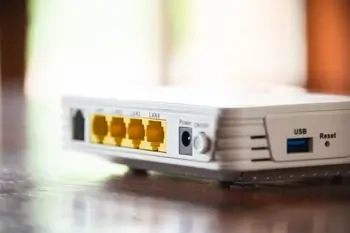What Is DD-WRT? How to Configure DD-WRT Routers
Installing third-party firmware is one way to improve a router's performance. DD-WRT is a sought-after firmware often used to get the most out of old consumer-grade routers. But not everyone knows how to customize their WiFi router’s firmware, as it can be a technical process. In this article, learn what DD-WRT is and how to set it up on your router.
What is DD-WRT?
DD-WRT stands for Dresden-Wireless Router. The DD part of the name refers to the “Dresden” city in Germany where it was first developed. The “WRT” abbreviation is short for “wireless router.”

Now, DD-WRT is a Linux-based open-source firmware for wireless routers and access points. Firmware controls a device's basic functions and operations and affects how it interacts with other devices.
DD-WRT offers a wide range of features and customization options that go beyond what most standalone router firmware provides. Some of the additional features include bandwidth management, a better interface, and the ability to restrict Internet access via a password and parental controls.
This software replaces the original software on your routers with a more feature-rich alternative. The process of replacing the default factory firmware on a router with DD-WRT firmware is called flashing.
While flashing your router improves its performance, the process isn’t without risks. If flashing is done incorrectly, it can cause irreparable damage to the router, rendering it unusable. This state is referred to as bricking because the router becomes as useful as a brick.
Setting up third-party firmware is risky, too, since it may void the manufacturer's warranty. This means if something goes wrong, you cannot seek help or a replacement from the manufacturer. Both risks may eventually result in you purchasing a new router, leading to additional expenses.
For these reasons, it’s recommended that you only install custom firmware when you identify an issue with your WiFi router that your existing firmware can’t deal with, or your default firmware doesn’t have the features and functionalities you want to implement on your network.
History and development of DD-WRT
DD-WRT was first developed in 2005 by Sebastian Gottschall. The aim was to create a more versatile and powerful firmware that could unlock the full potential of routers. Another focus was on adding a plethora of advanced features such as virtual private network capabilities, QoS, and hotspot functionality to its name.
The firmware was originally designed for the Linksys WRT54G series but has since expanded to support many wireless local area network (WLAN) routers from different manufacturers. This growth has been driven by contributions from a dedicated community of developers and users.
One key aspect of DD-WRT's success is its open-source nature. The firmware is published under the GPL license, making it free for anyone to use and modify.
This openness has fostered an active community that continuously contributes to the project's development even further. The support comes through forums, wikis, and other resources, helping users maximize the benefits of DD-WRT.
DD-WRT provides a professional version for commercial purposes. It includes enhanced security features and networking protocols for business environments. Over the years, several companies, most notably Buffalo Technology, have partnered with DD-WRT to produce routers with pre-installed DD-WRT firmware.
Features of DD-WRT
One of the primary reasons users opt for DD-WRT is the extensive range of features it offers.
Hotspot functionality
DD-WRT empowers your router to function as a WiFi hotspot, transforming it into a portable Internet access point. The hotspot network has customizable options, such as captive portals.
Wireless hotspots connect multiple devices to the Internet in places without WiFi within your backyard. In extension, the feature supports creating guest networks to segregate your main network from a guest network.
Network modes
DD-WRT supports various network modes like Access Point, Client Bridge, and repeater mode. It allows you to adapt your router to suit different networking needs.
- Access Point (AP) mode turns your router into a central hub that connects all your wireless devices to the network. It is ideal for expanding your wireless coverage in homes or offices.
- Client Bridge connects one router to another wirelessly and extends the network, effectively acting as a wireless bridge. The mode goes a step further to keep all devices on the same subnet.
- Repeater mode extends the range of your existing wireless network by repeating the signal from another router. The motive is to cover dead spots in larger areas. Repeater Bridge Mode combines the benefits of both bridging and repeating while maintaining a unified network.
Quality of Service (QoS) settings
Quality of Service (QoS) is a powerful feature in DD-WRT that allows you to prioritize specific types of network traffic, such as video streaming, over others. Such critical applications receive the bandwidth they need for optimal performance.
You can set QoS rules based on IP addresses, MAC addresses, or specific applications and services.
VPN support
Tighten your online privacy and security with DD-WRT's built-in VPN support. You can set up a virtual private network directly on your router to protect your entire home network from prying eyes.
DD-WRT supports popular VPN protocols, including OpenVPN, PPTP, and L2TP. OpenVPN is particularly popular because of its strong encryption.
Firewall settings
DD-WRT includes advanced firewall settings to protect your network from unauthorized access. You can configure the firewall to block specific IP addresses, ports, or protocols based on various criteria.
Besides, the firmware’s Stateful Packet Inspection (SPI) firewall is designed to analyze incoming and outgoing data packets in your network.
DNS caching and forwarding
DNS caching and forwarding accelerate website loading times by storing website addresses locally. With DNS caching, DD-WRT stores the results of these queries locally. Therefore, subsequent visits to the same website are faster because the DNS lookup is done directly from the cache.
DNS forwarding allows you to specify which DNS servers your network should use. While most routers default to using your ISP’s DNS servers, DD-WRT lets you choose faster third-party DNS services, such as OpenDNS.
IPv6 support
While IPv6 is the future of Internet addressing, the transition from IPv6 will eventually replace IPv4. Having a router that supports IPv6 is necessary for the future.
DD-WRT easily runs IPv6 which is more advanced. It also has a much larger pool of IP addresses.
Benefits of using DD-WRT
DD-WRT has numerous benefits that make it an attractive choice for router users. Some of the key advantages include:
- Many customization options. One of the main merits of DD-WRT is the extensive control it offers over your router's settings. With DD-WRT, you can modify your antenna settings, schedule Internet access, prevent specific types of activity, and so on.
- Advanced security features. DD-WRT provides VPN support and a robust firewall to protect your network from cyber threats.
- Increased network performance. It greatly improves your router and makes Internet connection a much better experience.
- Increases WiFi range. You can extend the range of your WiFi network by turning a regular router into a range extender.
- Prioritizes bandwidth. If you’re an avid streamer or gamer, then you’ll be concerned about speed to avoid delays. DD-WRT gives priority to selected applications, systems, or devices.
- Monitoring of results. DD-WRT presents more information about your network. It generates detailed statistics, charts, and graphs about your router's performance.
- Ability to utilize more advanced programs and services. On top of providing more control over your router's features, DD-WRT adds extra functions.
Troubleshooting common issues with DD-WRT
Despite its many advantages, DD-WRT can be challenging for first-time users. Here are the problems and how to resolve them:
- Router bricked after installation. If your router fails to boot after installing DD-WRT, it may be bricked. This can often be resolved by performing a 30-30-30 hard reset.
- VPN not connecting. If your VPN disconnects, double-check the configuration settings to ensure they support DD-WRT.
- The router reboots randomly. Overheating or incompatible settings can cause your router to reboot occasionally. Ensure that you put the router in a well-ventilated area and configure it correctly.
How to install DD-WRT on your router
Installing DD-WRT on your router is a straightforward process, but careful attention to detail is required to avoid bricking the device. Here’s a step-by-step guide:
- Check router compatibility. First, verify whether your router model is compatible with DD-WRT. The official DD-WRT website has a comprehensive database where you can check for supported routers.
- Download the correct firmware. Download the appropriate DD-WRT for your router model. Selecting the correct version is important to ensure a smooth installation.
- Back up your current settings. Before flashing the new firmware, back up your current router settings. This allows you to revert to the original firmware if anything goes wrong during the installation process.
- Reset the router. Perform a hard reset on your router to clear any existing settings.
- Upload the firmware. Access your router’s admin panel through a web browser and navigate to the firmware upgrade section. Upload the DD-WRT firmware file and initiate the flashing process. The process takes at least 10 minutes.
- Troubleshoot common issues during installation. Once the firmware is installed, the router will reboot. You can troubleshoot to fix any problem.
- Finish setting up DD-WRT. Access the DD-WRT interface through your web browser and then begin configuring your new, feature-rich router.
Frequently asked questions
Why should you run a VPN on a DD-WRT router?
DD-WRT boosts VPN performance, securing all your connected gadgets with a single VPN connection.
What factors do you consider when selecting a router for DD-WRT?
Keep your eyes on factors such as hardware specifications, compatibility, performance, coverage, advanced features, security, support, cost, and ease of use.
What are examples of the best routers for DD-WRT?
Routers like the Linksys WRT3200ACM, TP-Link Archer C7, and Asus RT-AC66U are exemplary choices for users looking to maximize performance using DD-WRT firmware.

